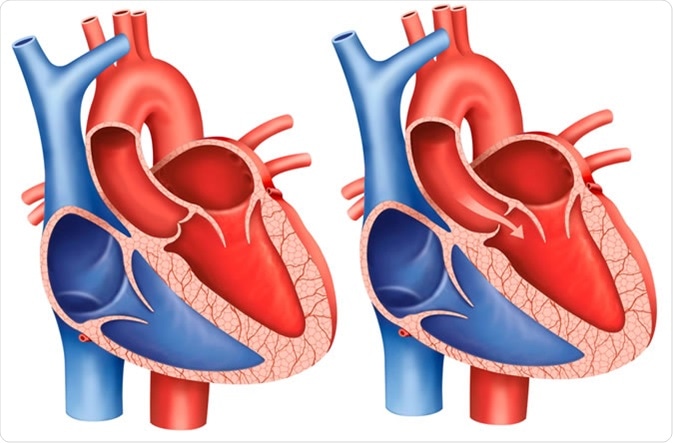Skip to:
Aortic stenosis is heart condition characterized by the narrowing of the left ventricle’s aortic valve due to environmental or congenital factors.
What is Aortic Stenosis?
Aortic stenosis (AS) is a condition affecting the heart characterized by the narrowing of the aortic valve of the left ventricle. Typically, the heart’s aortic valve opens during each contraction. This allows for blood to flow to the rest of the body from the heart via the aorta.
Any narrowing to the valve can result in an obstruction to the blood flow from the heart, and to combat this, results in the heart working more intensely to pump the necessary amount of blood around the body.
Typically, the aortic valve should measure between 3-4 cm². However, in those with AS, this could reduce to 1cm² or less.

Descriptive illustration of aortic valve stenosis, the main artery that carries blood out of the heart, the aortic valve does not open completely and decreases blood flow from the heart. - Illustration Credit: ilusmedical / Shutterstock
AS can be further classified as either supra-valvular, valvular, or sub-valvular depending on the severity of the obstruction. If the condition is not diagnosed and treated, then the condition may be left to progress resulting in a plethora of complications.
Symptoms of Aortic Stenosis
The symptoms experienced by those with aortic stenosis often depend on the severity of the blockage. For some with mild cases of the AS, significant symptoms may not be experienced. Therefore, the condition may only be picked up by the presence of a heart murmur during a physical examination.
In more severe cases, some of the following symptoms may be experienced:
- Fainting due to a lack of blood flow
- Angina which is often brought on when engaging in physical activity
- Shortness of breath. Particularly when exercising, but as the condition progresses, this may be noted at rest
- Syncope (fainting)
- Swollen ankles
- Fatigue
Understanding Aortic Stenosis with Dr. Marc Gillinov
Causes of Aortic Stenosis
Research has found several causes of AS linked to both environmental and congenital factors. The build-up of calcium deposits in the hearts’ aortic valve that occurs as we age is one of the most common causes of AS. As a result of the build-up, an inflammatory response causing the valve to become more rigid and narrower.
For some, AS may be caused due to a congenital abnormality whereby the valve is comprised of only two cusps instead of three. This may cause the value to naturally be narrower and increase the likelihood of the build-up of calcium.
In addition to this, researchers have found a link between underlying medical conditions and AS. For example, those with Ehlers-Danlos syndrome, endocarditis, Marfan syndrome, and lupus are more likely to develop AS due to the damage caused to the aortic valve by the conditions.
Complications of Aortic Stenosis
There is a range of complications that may occur in those with aortic stenosis, particularly in instances where the individual is unaware they have the condition. The most common health issues include the development of abnormal heart patterns, heart failure and heart attack.
How is Aortic Stenosis Diagnosed?
Some patients with aortic stenosis may experience symptoms of breathlessness or chest pain which can then be investigated by a doctor. However, other patients may be asymptomatic. In this case, the condition may only be identified if a crescendo-decrescendo heart murmur is heard during physical examination. An echocardiography may then be carried out to confirm the patient has AS.
Treatment Options
There is a range of treatment options available to help address the symptoms associated with AS. As aortic stenosis can occur due to a build-up of calcium deposits, one treatment method aims to lower lipid levels. For example, Hydroxymethylglutaryl-coenzyme - an inhibitor of the enzyme A reductase – otherwise known as statins may be prescribed to slow down the progression of the condition. Other medication typically prescribed includes bisphosphonates and angiotensin-converting enzyme inhibitors.
In severe symptomatic and asymptomatic cases, valve replacement surgery may be required to manage the disease.
Sources
- Nathaniel, S., Saligram, S., Innasimuthu, A. L. (2010). Aortic stenosis: An update. World Journal of Cardiology. DOI: 10.4330/wjc.v2.i6.135
- NHS (2018). Aortic valve replacement: Why it’s done. DOI: https://www.nhs.uk/conditions/aortic-valve-replacement/whyitsdone/
- Czarny M. J., & Resar J. R. (2014). Diagnosis and Management of Valvular Aortic Stenosis. Clinical Medicine Insights: Cardiology. DOI: 10.4137/CMC.S15716
- Harris C., Croce B., & Phan K. (2015). Aortic stenosis. Annals of Cardiothoracic Surgery. DOI: 10.3978/j.issn.2225-319X.2014.12.11
- Maganti K., Rigolin V. H., Enriquez M., et al. (2010). Valvular Heart Disease: Diagnosis and Management. Mayo Clinic Proceedings. DOI: 10.4065/mcp.2009.0706
- Baumgartner, H. (2005). Aortic stenosis: medical and surgical management. Heart. DOI: 10.1136/hrt.2004.056176
Further Reading
Last Updated: Oct 9, 2019